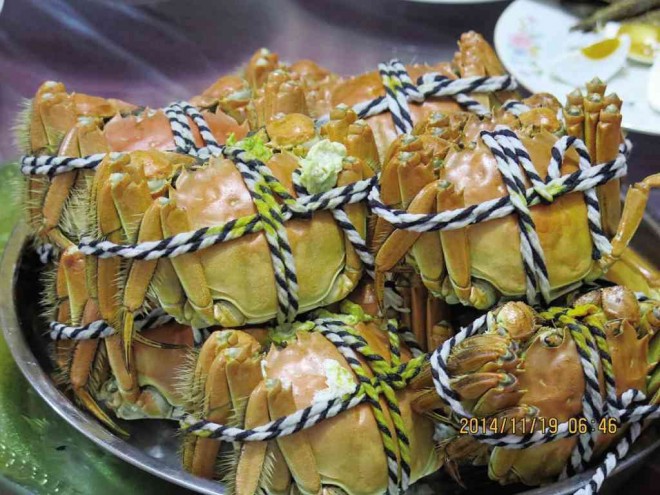
Shanghai hairy crab was top of mind in the agenda as soon as we landed at Pudong Airport in Shanghai. We thought how nice it would be to eat this famous fat crab right in its place of origin.
And we thought it would be available in any restaurant because it’s been the town’s specialty and the autumn cool weather season was right.
Photographer Neal Oshima and I were guests of the Philippine Consulate, which exhibited his Filipino food photographs and my words taken from the book “Kulinarya: A Guidebook to Philippine Cuisine.”
At the Filipino food festival dinner, Oshima’s seatmates recommended places to go to, markets to visit. One volunteered to bring us to a place where we could have hairy crab.
The date was set for our hairy crab experience, but our guide couldn’t make it in time for dinner, and so asked a friend, Sammi Zheng, to go in her stead.
Zheng’s credentials as executive director of a Hong Kong company didn’t matter more to us than her being a certified foodie.
First thing Zheng did was look us over and asked those of us too lightly dressed to wear warmer clothing, as we were going by boat to an island in the middle of a lake. That sounded already like an adventure.
In an hour and a half, we were in another city, Suzhou. There Zheng pointed out Yangcheng Lake where the most prized hairy crabs are harvested.
The van turned on a deserted road lined with restaurants. These eateries, she said, served the crab, but some of those sold weren’t really from the lake.
We arrived at a pier with a crab “farmer” named Zhong waiting for us to board his little boat. He navigated through the darkness, guided by lights that marked the nets holding the crabs underneath.
We arrived on Lotus Island, a village where other boats were docked.
We were greeted by Mrs. Zhong and ushered to her home. It was dark, save for the light in the dining area; it was also the season for lake flies (like gamu-gamo, or moths) that would invade later some of our food.
Main event
The hairy crabs (also known as Chinese mitten crabs) were in an aquarium.
Farmer Zhong sold most of his catch to wholesale merchants. The season started in September and, toward December, the crabs got bigger, our guide said.
The farmer and his wife looked amused as we asked to see the kitchen. The crabs were cooking in a steamer; there were other dishes being done. We were surprised at how many dishes the woman of the house prepared for us.
We had food from the lake—snails (small kuhol), steamed white fish that was like the famous Hangzhou fish, red radish that grows on the water and which our hostess pickled.
Appetizers consisted of smoked fish (like Salinas tinapa), fried freshwater shrimps (small ulang), salted eggs, scrambled eggs, pickled cucumber and peanuts.
Before the main event, we had braised goose with potatoes, chicken boiled to perfection and tasting of my grandmother’s tinola, stir-fried mixed vegetables and a separate one of just cabbage.
Boiled corn, the sticky whitish variety, was served; it was supposed to be the carbo we needed, but we asked for rice just the same, which amused farmer Zhong. Rice and crabs go together, we tried to explain to him.
At last the crabs came, served with striped black-and-white rope tied around each body; the crab appendages were still there. Our guide Zheng pointed out the female and male crabs, but she was in for a surprise when we said there was such a thing as gay crabs as well.
The crab’s hairy part is near the legs. The important thing to remember, said our guide, is to remove a small white part in the roe, which is supposed to be the heart, because it will heat up the body. Actually we could do with warmth in that cold weather.
Creamier
Like other crabs, the males had yellowish fat, while the females had red roe. I prefer the male because the fat is creamier. If you are used to cracking crabs, it won’t be a problem with the Shanghai variety.
The difficulty is cracking the legs, because the hairy crab has a harder shell. While we were given kitchen shears, those were not as good as crushing the shells with a pestle or the back of a big knife, as I do back home.
Zheng showed us how, but it was only Oshima who got it right, down to opening up the claws with his fingers.
For the small legs, after snipping off the ends, a chopstick was pushed through to get the meat out. A dipping sauce of sweetish black vinegar completed the experience.
The drink to go with the crab was a yellow wine heated with ginger, which reminded us of salabat.
It would have been best to be in the place for lunch so we could see the village and its people, and we could eat without being bothered by the lake flies.
But it was the best place to eat the real Shanghai hairy crab which no Chinese restaurant, no matter how plush, could have provided.
And I think for all that good food that six of us ate, the bill came to about P1,600 each—well worth the travel.
Sammi Zheng said she went with friends there even in the summer, even when hairy crabs were not available, just for the food and the hospitality of farmer Zhong and his wife.
Then she smiled as she recounted how some guests got so inebriated that they jumped into the lake by the pier.
Maybe next time we could do that.
E-mail pinoyfood04@yahoo.com